Tesla autopilot feature didn't have a safety defect, US regulators conclude in fatal crash probe
The investigation report said that the driver had enough time to react.

The National Highway Traffic Safety Administration has concluded that the fatal crash of a Tesla S model which led to death of Joshua Brown, a 40-year-old former Navy SEAL in May 2016, was not the company's fault.
The report, which comes after six months of investigation, said Tesla's autopilot system was semi-autonomous that allowed the car to steer, brake, cruise and change lanes themselves under certain circumstances. It was not a fully self-driving capable vehicle and therefore, the driver should have been alert. The report also said that the driver had seven seconds during which he could have taken action.
"There was enough lead time to take some action," said Bryan Thomas, an NHTSA spokesman, adding that it is still unclear if Brown's prompt reaction could have mitigated or avoided the crash altogether.
Brown was killed shortly after the Tesla car collided with an 18-wheel tractor trailer on a Florida highway.
The report comes as relief for Tesla, whose technology was questioned with many asking why the breaking system did not perform on time. The company on its part said the autopilot failed to detect the truck's white trailer against a brightly lit sky.
Despite the clearance given to Tesla the regulators said they would continue to closely monitor self-driving technologies and asked motoring companies not to give drivers a false sense of security when using such systems.
Months after the crash the company introduced a software upgrade in Tesla that Chief Executive Elon Musk claimed "very likely" would have prevented the May collision. Further in October the company announced that all its future cars will be installed with autopilot hardware which aims to reduce crashes. Most of these features will however, remain dormant unless clearances are granted by authorities.
© Copyright IBTimes 2025. All rights reserved.





















